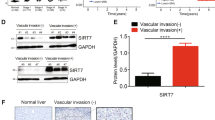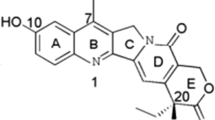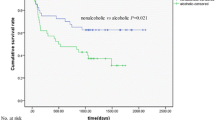Abstract
Cell metastasis, especially the process of invasion and migration, is considered as the main cause for the high mortality rate of hepatocellular carcinoma (HCC), which has become the sixth most common cancer worldwide and the third leading cause of cancer death. In this present study, we aimed to exploit the effects of perillyl alcohol on cell invasion and migration and the underlying molecular mechanisms in HCC. According to the transwell assays, cell invasiveness and migratory capacity were markedly higher in hepatoma cells (HepG2, SMMC-7721 and MHCC97H) than those in normal liver cells (HL-7702), and then significantly suppressed by perillyl alcohol treatment (P < 0.05). Meanwhile, the mRNA levels of Notch signaling pathway downstream target genes, HES1, HES5, and HEY1, were notably higher in hepatoma cells detected with real-time reverse transcription polymerase chain reaction (RT-PCR) (P < 0.05). After treated with perillyl alcohol, these mRNA levels were significantly decreased in hepatoma cells (P < 0.05). In addition, compared with the normal liver cells, the protein expression levels of Notch1 intracellular domain (N1ICD) and Snail were significantly increased, while E-cadherin protein expression was significantly decreased in hepatoma cells (P < 0.05). However, perillyl alcohol treatment significantly decreased N1ICD and Snail protein expressions and increased E-cadherin protein expression in hepatoma cells (P < 0.05). In conclusion, perillyl alcohol might play an important role in the process of hepatoma cell invasion and migration via decreasing the activity of Notch signaling pathway and increasing E-cadherin expression regulated by Snail.






Similar content being viewed by others
References
European Association for Study of L, European Organisation for R, Treatment of C (2012) EASL-EORTC clinical practice guidelines: management of hepatocellular carcinoma. Eur J Cancer 48(5):599–641. doi:10.1016/j.ejca.2011.12.021
Jemal A, Bray F, Center MM, Ferlay J, Ward E, Forman D (2011) Global cancer statistics. CA Cancer J Clin 61(2):69–90
Comijn J, Berx G, Vermassen P, Verschueren K, van Grunsven L, Bruyneel E, Mareel M, Huylebroeck D, van Roy F (2001) The two-handed E box binding zinc finger protein SIP1 downregulates E-cadherin and induces invasion. Mol Cell 7(6):1267–1278
Cano A, Perez-Moreno MA, Rodrigo I, Locascio A, Blanco MJ, del Barrio MG, Portillo F, Nieto MA (2000) The transcription factor snail controls epithelial-mesenchymal transitions by repressing E-cadherin expression. Nat Cell Biol 2(2):76–83. doi:10.1038/35000025
Newman DJ (2008) Natural products as leads to potential drugs: an old process or the new hope for drug discovery? J Med Chem 51(9):2589–2599. doi:10.1021/jm0704090
Imamura M, Sasaki O, Okunishi K, Nakagome K, Harada H, Kawahata K, Tanaka R, Yamamoto K, Dohi M (2014) Perillyl alcohol suppresses antigen-induced immune responses in the lung. Biochem Biophys Res Commun 443(1):266–271. doi:10.1016/j.bbrc.2013.11.106
Teruszkin Balassiano I, Alves de Paulo S, Henriques Silva N, Curie Cabral M, Gibaldi D, Bozza M, Orlando da Fonseca C, Gloria Da, da Costa Carvalho M (2002) Effects of perillyl alcohol in glial C6 cell line in vitro and anti-metastatic activity in chorioallantoic membrane model. Int J Mol Med 10(6):785–788
Wagner JE, Huff JL, Rust WL, Kingsley K, Plopper GE (2002) Perillyl alcohol inhibits breast cell migration without Affecting Cell Adhesion. J Biomed Biotechnol 2(3):136–140. doi:10.1155/S1110724302207020
Low-Baselli A, Huber WW, Kafer M, Bukowska K, Schulte-Hermann R, Grasl-Kraupp B (2000) Failure to demonstrate chemoprevention by the monoterpene perillyl alcohol during early rat hepatocarcinogenesis: a cautionary note. Carcinogenesis 21(10):1869–1877
Lebedeva IV, Su ZZ, Vozhilla N, Chatman L, Sarkar D, Dent P, Athar M, Fisher PB (2008) Mechanism of in vitro pancreatic cancer cell growth inhibition by melanoma differentiation-associated gene-7/interleukin-24 and perillyl alcohol. Cancer Res 68(18):7439–7447. doi:10.1158/0008-5472.CAN-08-0072
Wagner JE, Huff JL, Rust WL, Kingsley K, Plopper GE (2002) Perillyl alcohol inhibits breast cell migration without affecting cell adhesion. BioMed Res Int 2(3):136–140
Afshordel S, Kern B, Clasohm J, König H, Priester M, Weissenberger J, Kögel D, Eckert GP (2015) Lovastatin and perillyl alcohol inhibit glioma cell invasion, migration, and proliferation–Impact of Ras-/Rho-prenylation. Pharmacol Res 91:69–77
Berchtold CM, Chen KS, Miyamoto S, Gould MN (2005) Perillyl alcohol inhibits a calcium-dependent constitutive nuclear factor-kappaB pathway. Cancer Res 65(18):8558–8566. doi:10.1158/0008-5472.CAN-04-4072
Chaudhary SC, Alam MS, Siddiqui MS, Athar M (2009) Perillyl alcohol attenuates Ras-ERK signaling to inhibit murine skin inflammation and tumorigenesis. Chem Biol Interact 179(2–3):145–153. doi:10.1016/j.cbi.2008.12.016
Tremblay I, Pare E, Arsenault D, Douziech M, Boucher MJ (2013) The MEK/ERK pathway promotes NOTCH signalling in pancreatic cancer cells. PLoS ONE 8(12):e85502. doi:10.1371/journal.pone.0085502
Aithal MG, Rajeswari N (2013) Role of Notch signalling pathway in cancer and its association with DNA methylation. J Genet 92(3):667–675
Bae GY, Choi SJ, Lee JS, Jo J, Lee J, Kim J, Cha HJ (2013) Loss of E-cadherin activates EGFR-MEK/ERK signaling, which promotes invasion via the ZEB1/MMP2 axis in non-small cell lung cancer. Oncotarget 4(12):2512–2522
Wang XQ, Zhang W, Lui EL, Zhu Y, Lu P, Yu X, Sun J, Yang S, Poon RT, Fan ST (2012) Notch1-Snail1-E-cadherin pathway in metastatic hepatocellular carcinoma. Int J Cancer 131(3):E163–E172. doi:10.1002/ijc.27336
Bassi AM, Romano P, Mangini S, Colombo M, Canepa C, Nanni G, Casu A (2005) Protein and m-RNA expression of farnesyl-transferases, RhoA and RhoB in rat liver hepatocytes: action of perillyl alcohol and vitamin A in vivo. J Biomed Sci 12(3):457–466. doi:10.1007/s11373-005-3728-y
Mills JJ, Chari RS, Boyer IJ, Gould MN, Jirtle RL (1995) Induction of apoptosis in liver tumors by the monoterpene perillyl alcohol. Cancer Res 55(5):979–983
Sultana S, Nafees S, Khan AQ (2013) Perillyl alcohol as a protective modulator against rat hepatocarcinogenesis via amelioration of oxidative damage and cell proliferation. Hum Exp Toxicol 32(11):1179–1192. doi:10.1177/0960327112474834
Wang T, Xuan X, Pian L, Gao P, Hu H, Zheng Y, Zang W, Zhao G (2014) Notch-1-mediated esophageal carcinoma EC-9706 cell invasion and metastasis by inducing epithelial-mesenchymal transition through Snail. Tumour Biol 35(2):1193–1201. doi:10.1007/s13277-013-1159-3
Ranganathan P, Weaver KL, Capobianco AJ (2011) Notch signalling in solid tumours: a little bit of everything but not all the time. Nat Rev Cancer 11(5):338–351. doi:10.1038/nrc3035
Du X, Cheng Z, Wang YH, Guo ZH, Zhang SQ, Hu JK, Zhou ZG (2014) Role of Notch signaling pathway in gastric cancer: a meta-analysis of the literature. World J Gastroenterol 20(27):9191–9199. doi:10.3748/wjg.v20.i27.9191
Mazzone M, Selfors LM, Albeck J, Overholtzer M, Sale S, Carroll DL, Pandya D, Lu Y, Mills GB, Aster JC (2010) Dose-dependent induction of distinct phenotypic responses to Notch pathway activation in mammary epithelial cells. Proc Natl Acad Sci 107(11):5012–5017
Katoh M, Katoh M (2007) Integrative genomic analyses on HES/HEY family: notch-independent HES1, HES3 transcription in undifferentiated ES cells, and Notch-dependent HES1, HES5, HEY1, HEY2, HEYL transcription in fetal tissues, adult tissues, or cancer. Int J Oncol 31(2):461–466
Gao F, Zhang Y, Wang S, Liu Y, Zheng L, Yang J, Huang W, Ye Y, Luo W, Xiao D (2014) Hes1 is involved in the self-renewal and tumourigenicity of stem-like cancer cells in colon cancer. Sci Rep 4:3963. doi:10.1038/srep03963
Koch U, Radtke F (2007) Notch and cancer: a double-edged sword. Cell Mol Life Sci 64(21):2746–2762
Candy P, Phillips M, Redfern A, Colley S, Davidson J, Stuart L, Wood B, Zeps N, Leedman P (2013) Notch-induced transcription factors are predictive of survival and 5-fluorouracil response in colorectal cancer patients. Br J Cancer 109(4):1023–1030
Morell CM, Fiorotto R, Fabris L, Strazzabosco M (2013) Notch signalling beyond liver development: emerging concepts in liver repair and oncogenesis. Clin Res Hepatol Gastroenterol 37(5):447–454. doi:10.1016/j.clinre.2013.05.008
Yeruva L, Pierre KJ, Elegbede A, Wang RC, Carper SW (2007) Perillyl alcohol and perillic acid induced cell cycle arrest and apoptosis in non small cell lung cancer cells. Cancer Lett 257(2):216–226
Zhou L, D-s Wang, Q-j Li, Sun W, Zhang Y, K-f Dou (2013) The down-regulation of Notch1 inhibits the invasion and migration of hepatocellular carcinoma cells by inactivating the cyclooxygenase-2/Snail/E-cadherin pathway in vitro. Dig Dis Sci 58(4):1016–1025
Yang N, Tang Y, Wang F, Zhang H, Xu D, Shen Y, Sun S, Yang G (2013) Blockade of store-operated Ca(2 +) entry inhibits hepatocarcinoma cell migration and invasion by regulating focal adhesion turnover. Cancer Lett 330(2):163–169. doi:10.1016/j.canlet.2012.11.040
Liu X, Chu KM (2014) E-Cadherin and Gastric Cancer: cause, Consequence, and Applications. Biomed Res Int 2014:637308. doi:10.1155/2014/637308
Kang H, Lee M, Jang SW (2013) Celastrol inhibits TGF-beta1-induced epithelial-mesenchymal transition by inhibiting Snail and regulating E-cadherin expression. Biochem Biophys Res Commun 437(4):550–556. doi:10.1016/j.bbrc.2013.06.113
Yan HB, Wang XF, Zhang Q, Tang ZQ, Jiang YH, Fan HZ, Sun YH, Yang PY, Liu F (2014) Reduced expression of the chromatin remodeling gene ARID1A enhances gastric cancer cell migration and invasion via downregulation of E-cadherin transcription. Carcinogenesis 35(4):867–876. doi:10.1093/carcin/bgt398
Barrallo-Gimeno A, Nieto MA (2005) The Snail genes as inducers of cell movement and survival: implications in development and cancer. Development 132(14):3151–3161
Yin T, Wang C, Liu T, Zhao G, Zha Y, Yang M (2007) Expression of snail in pancreatic cancer promotes metastasis and chemoresistance. J Surg Res 141(2):196–203
Kudo-Saito C, Shirako H, Takeuchi T, Kawakami Y (2009) Cancer metastasis is accelerated through immunosuppression during Snail-induced EMT of cancer cells. Cancer Cell 15(3):195–206
Panelos J, Batistatou A, Paglierani M, Zioga A, Maio V, Santi R, Pimpinelli N, De Giorgi V, Santucci M, Massi D (2009) Expression of Notch-1 and alteration of the E-cadherin/beta-catenin cell adhesion complex are observed in primary cutaneous neuroendocrine carcinoma (Merkel cell carcinoma). Mod Pathol 22(7):959–968. doi:10.1038/modpathol.2009.55
Chen J, Imanaka N, Chen J, Griffin JD (2010) Hypoxia potentiates Notch signaling in breast cancer leading to decreased E-cadherin expression and increased cell migration and invasion. Br J Cancer 102(2):351–360. doi:10.1038/sj.bjc.6605486
Timmerman LA, Grego-Bessa J, Raya A, Bertrán E, Pérez-Pomares JM, Díez J, Aranda S, Palomo S, McCormick F, Izpisúa-Belmonte JC (2004) Notch promotes epithelial-mesenchymal transition during cardiac development and oncogenic transformation. Genes Dev 18(1):99–115
Bolos V, Mira E, Martinez-Poveda B, Luxan G, Canamero M, Martinez AC, Manes S, de la Pompa JL (2013) Notch activation stimulates migration of breast cancer cells and promotes tumor growth. Breast Cancer Res 15(4):R54. doi:10.1186/bcr3447
Author information
Authors and Affiliations
Corresponding author
Ethics declarations
Conflict of interests
The authors declare that they have no conflict of interests to state.
Rights and permissions
About this article
Cite this article
Ma, Y., Bian, J. & Zhang, F. Inhibition of perillyl alcohol on cell invasion and migration depends on the Notch signaling pathway in hepatoma cells. Mol Cell Biochem 411, 307–315 (2016). https://doi.org/10.1007/s11010-015-2593-x
Received:
Accepted:
Published:
Issue Date:
DOI: https://doi.org/10.1007/s11010-015-2593-x




